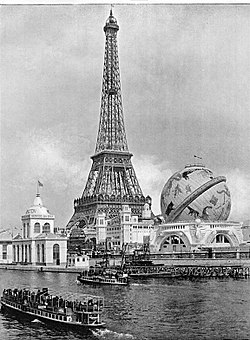Globe Céleste


The Globe Céleste was an icon of the Exposition Universelle of 1900 in Paris, similar to the Eiffel Tower.[clarification needed] It was constructed in the shape of a large globe and stood close to the Eiffel Tower. It was in the form of a blue and gold sphere, 45 meters in diameter, on which were painted the constellations and signs of the zodiac. The sphere rested on a base about 18 meters high, made up of four masonry pillars that housed staircases and elevators, giving access to a flower-decked terrace at the top of the globe that was "catered for armchair space-travellers: spectators leaned back in easy chairs while panoramas depicting the solar system were rolled past."[1]
The attraction had been designed by and built according to the Matrai system.
On April 29, 1900, the pedestrian bridge to the tourist attraction collapsed near Suffren Avenue, killing 9 people and injuring several others. The accident led the French authorities to an inquiry. The Committee on Reinforced Cement was created by the ministerial decree of December 19, 1900. A later judicial proceeding held the City of Paris responsible, condemning it for carrying out excavations too close to the bridge which led to its collapse.[citation needed]
References[]
- ^ Google Books: Maxwell, Anne – Colonial Photography and Exhibitions, 1999, ISBN 0-7185-0229-9 p. 25 below[where?]
Coordinates: 48°51′27″N 2°17′34″E / 48.85750°N 2.29278°E
- Exposition Universelle (1900)
- World's fair architecture in Paris
- France stubs
